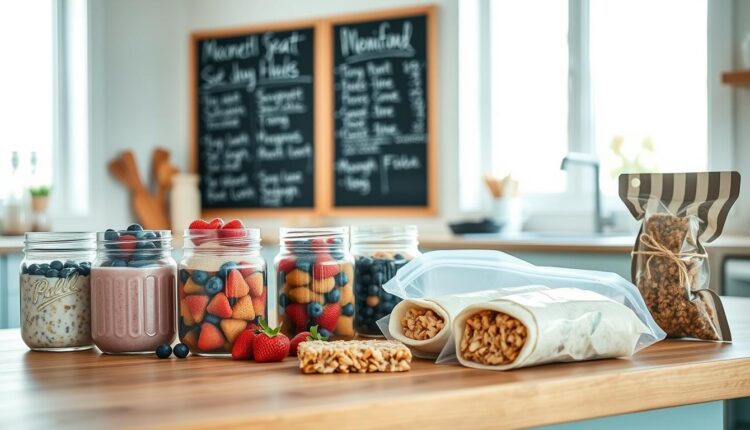Low Sugar Breakfast Freezer Friendly For Monthly Prep
Simplify meal prep with our list of low sugar breakfast freezer friendly options. Prep ahead, save time, and enjoy healthy breakfasts all month.
I used to burn toast while scrambling eggs as my coffee went cold. Then I discovered the magic of preparing nourishing morning meals before the weekday rush. Now my freezer holds ready-to-heat breakfasts that keep energy steady without sugar spikes.
This approach isn’t about perfection—it’s practicality. Oats become creamy bakes, eggs transform into portable cups, and whole grains turn into grab-and-go squares. Each batch takes about as much effort as loading the dishwasher. Best part? You’ll find dietitian-approved make-ahead breakfasts work whether you’re feeding a family or just yourself.
Here’s what we’re covering:
- Simple ingredient swaps to cut sweetness without sacrificing flavor
- How to store meals so they taste fresh all month
- My favorite 10-minute reheating tricks (no microwave required!)
Nourishing your body shouldn’t feel like solving a Rubik’s cube before caffeine. Let’s create a morning rhythm that actually works.
Introduction to a Time-Saving Breakfast Routine
Rushing out the door without eating became my norm—until I learned a better way. Now, my mornings begin with calm instead of chaos. The secret? Treating breakfast like a non-negotiable appointment with your future self.
Why Prioritizing Breakfast Matters
Your first meal sets the tone for the day. Skipping it leaves you chasing energy with coffee and snacks. I learned this the hard way during a week of back-to-back meetings—by Thursday, my focus felt like a deflated balloon.
Balanced morning meals do more than fill your stomach. They stabilize mood, sharpen concentration, and prevent mid-morning crashes. My go-to? Recipes combining fiber-rich oats with protein-packed eggs. This duo keeps hunger at bay until lunch naturally.
How Meal Prep Simplifies Your Morning
Spending 90 minutes on Sundays transformed my workweek. Instead of daily cooking marathons, I reheat nutrient-dense meals while brewing tea. The time math works: 15 minutes daily vs. 2 hours weekly.
| Task | Without Prep | With Prep |
|---|---|---|
| Daily Cooking | 15-20 minutes | 3 minutes |
| Weekly Planning | 45 minutes | 20 minutes |
| Morning Stress | High | None |
Last Tuesday proved the system works. My car wouldn’t start, but breakfast was ready in 90 seconds—giving me extra time to problem-solve. That’s the power of planning ahead.
Benefits of Prepping Low Sugar Breakfasts in Advance
Last month, my blender exploded kale smoothie on the ceiling—right before a client call. That’s when I fully committed to prepared morning meals. Now, my kitchen stays clean, and my energy stays steady thanks to recipes designed for busy schedules.
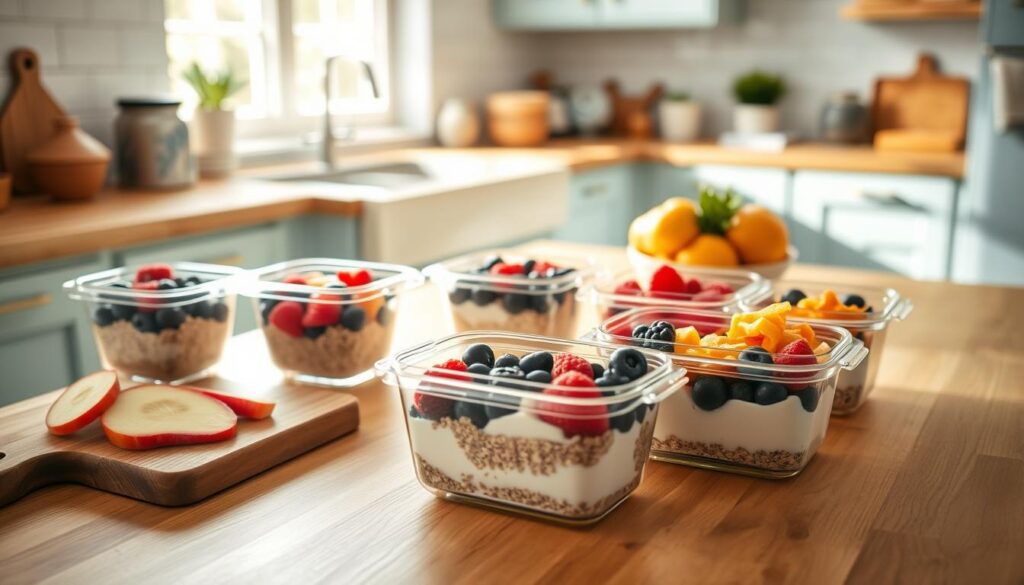
Prepping ahead turns chaotic mornings into calm routines. You’ll gain 10-15 minutes daily—time better spent sipping tea or reviewing emails. A Johns Hopkins study found people who eat morning meals consistently make healthier choices all day.
| Morning Task | Without Prep | With Prep |
|---|---|---|
| Decision Fatigue | High | None |
| Nutrition Quality | Unbalanced | Protein + Fiber Focused |
| Time Spent | 12 minutes avg. | 2 minutes |
My egg muffin cups prove freezer meals can taste fresh. Spinach, peppers, and feta pack protein while oats provide fiber. Reheating preserves texture better than you’d expect—no rubbery eggs here.
This approach isn’t just about saving minutes. It’s about starting your day with intention. When your body gets balanced nutrition early, you’re less likely to crave sugary snacks by 10 AM. Plus, you’ll free up mental space for what truly matters.
Key Ingredients for Healthy, Low Sugar Breakfasts
The first time I made egg muffins, they stuck to the pan like glue. Now I know the secret: a trusty silicone tray and the right ingredients. Two staples transformed my morning meals—cage-free eggs and rolled oats. These kitchen heroes form the base of countless nourishing creations.
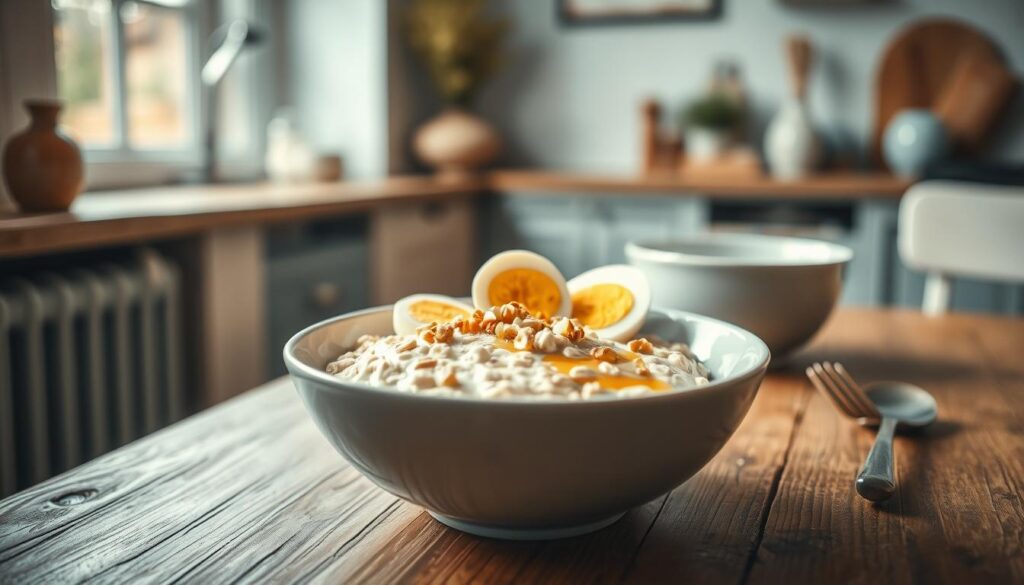
Nutritional Spotlight on Eggs and Oats
Eggs deliver complete protein that keeps you full for hours. I rotate between scrambles, muffin cups, and burrito fillings—each batch takes minutes to assemble. Last week’s experiment? Smoky paprika egg bites with roasted red peppers. Even my picky nephew asked for seconds.
Oatmeal’s soluble fiber works like a sponge in your gut, slowing digestion. When baked into bars or stirred into muffin batter, it creates a hearty texture. My favorite combo: mashed banana mixed into overnight oats. The fruit’s natural sweetness means zero added sugars.
- Savory egg cups with spinach and feta
- Oatmeal bake layered with cinnamon apples
- Banana-oat pancakes (freeze beautifully!)
A pat of butter adds richness without overpowering. I use half a teaspoon per serving in baked goods—enough to enhance flavor while keeping nutrition balanced. These ingredients adapt to any craving. Sweet or savory, they’re the foundation of meals that fuel your day.
Planning Your Monthly Breakfast Prep
I once tried prepping 30 days of meals in one afternoon—my kitchen looked like a flour bomb detonated. Now, I plan smarter. The key? Treating your monthly meal strategy like a puzzle where each piece (recipe) fits your schedule.
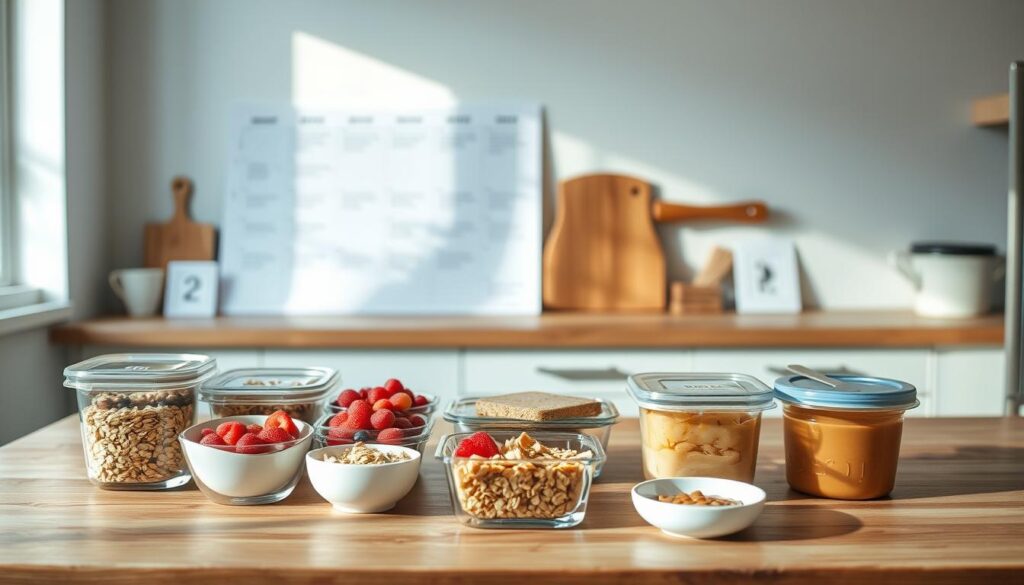
Start with a Sunday reset day. Block 2 hours weekly to batch-cook staples. Alternate savory and sweet options to keep mornings interesting. For example:
| Week | Savory Recipe | Sweet Recipe |
|---|---|---|
| 1 | Spinach-feta egg burritos | Apple-cinnamon oat cups |
| 2 | Turkey sausage muffins | Blueberry chia pudding |
| 3 | Sweet potato breakfast bowls | Pumpkin spice baked oats |
This rotation prevents taste fatigue. I dedicate 20 minutes each planning session to inventory check-ins—no more discovering six identical bean burritos behind frozen fruit.
Work with your schedule’s natural rhythms. If Wednesdays are hectic, assign simpler recipes those days. My neighbor swears by Thursday night prep sessions—she watches her favorite show while assembling meals.
Stagger cooking days to avoid freezer overload. Make double batches of versatile bases like shredded chicken or roasted veggies. They transform into breakfast tacos, scrambles, or grain bowls depending on the day.
A solid plan turns meal prep from chore to creative outlet. Last month’s smoked paprika black bean burritos started as a fridge cleanout experiment. Now they’re in regular rotation—proof that structure fuels kitchen magic.
Tips for Freezing and Reheating Breakfasts
My first freezer breakfast experiment ended with a shattered glass container—lesson learned the hard way. Now I use these proven methods to keep meals tasting fresh and safe to eat. The trick lies in how you store and revive your creations.

Always cool cooked items completely before freezing. Portion egg muffins or oat bakes into single servings using silicone molds. This prevents ice crystals from forming. I stack them in airtight containers with parchment paper between layers.
| Reheating Method | Time | Best For | Pro Tip |
|---|---|---|---|
| Microwave (50% power) | 1-2 minutes | Egg cups, oatmeal | Cover with damp paper towel |
| Oven (350°F) | 8-12 minutes | Baked goods, burritos | Wrap in foil first |
For fluffy eggs, reheat muffin cups at 30-second intervals. Stir halfway through. Burritos regain crispness when finished uncovered in the oven. Let items rest 1 minute post-heating—this distributes warmth evenly.
Use freezer-safe bags labeled with dates. Squeeze out excess air to prevent freezer burn. Most prepped meals stay fresh 2-3 months. Thaw overnight in the refrigerator for best texture, especially for grain-based recipes.
Last week’s sweet potato hash reheated perfectly using this system. The oven method restored its caramelized edges—proof that frozen doesn’t mean flavorless. With these techniques, your morning fuel stays delicious from freezer to plate.
Creative Recipe Ideas for Freezer Friendly Mornings
I once served guests a frittata that resembled a charcoal briquette. That disaster taught me to embrace recipes designed for real life—not Pinterest perfection. These creations thrive in the freezer and adapt to your taste buds.
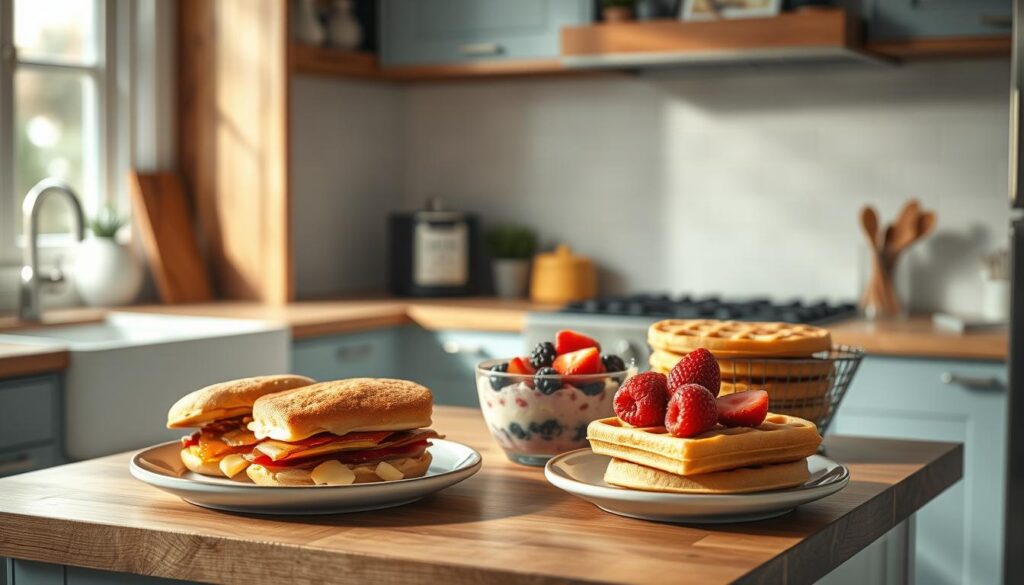
Egg-Based Breakfast Variations
Eggs are the ultimate blank canvas. Try these twists:
- Spinach-feta egg cups: Whisk 8 eggs with garlic powder, then fold in chopped spinach and crumbled feta
- Southwest burritos: Scrambled eggs, black beans, and roasted peppers wrapped in whole-grain tortillas
- Mini omelet bites: Silicone muffin tins create single-serving portions with endless mix-ins
My neighbor swears by her “clean-out-the-fridge” scramble. “I toss leftover roasted veggies into muffin tins with eggs—breakfast for three days sorted,” she shared.
Grain and Muffin Options
Whole grains transform into portable fuel when prepped smartly:
| Recipe | Base | Flavor Boost | Reheating Tip |
|---|---|---|---|
| Savory oatmeal bowls | Steel-cut oats | Parmesan + sun-dried tomatoes | Add broth when reheating |
| Zucchini muffins | Almond flour | Cheddar + smoked paprika | Toast for crunch |
For sweet cravings, mash ripe bananas into oat batter. Fold in dark chocolate chips or walnuts before freezing. The key? Portion everything before freezing—it prevents that sad, stuck-together muffin cluster.
Low Sugar Breakfast Freezer Friendly: Featured Recipes
I discovered the perfect breakfast burrito after three failed attempts and a smoke alarm incident. Now these flavor-packed creations anchor my freezer stash—proof that trial and error leads to morning wins. Below are my kitchen-tested favorites that deliver bold taste without sugar spikes.
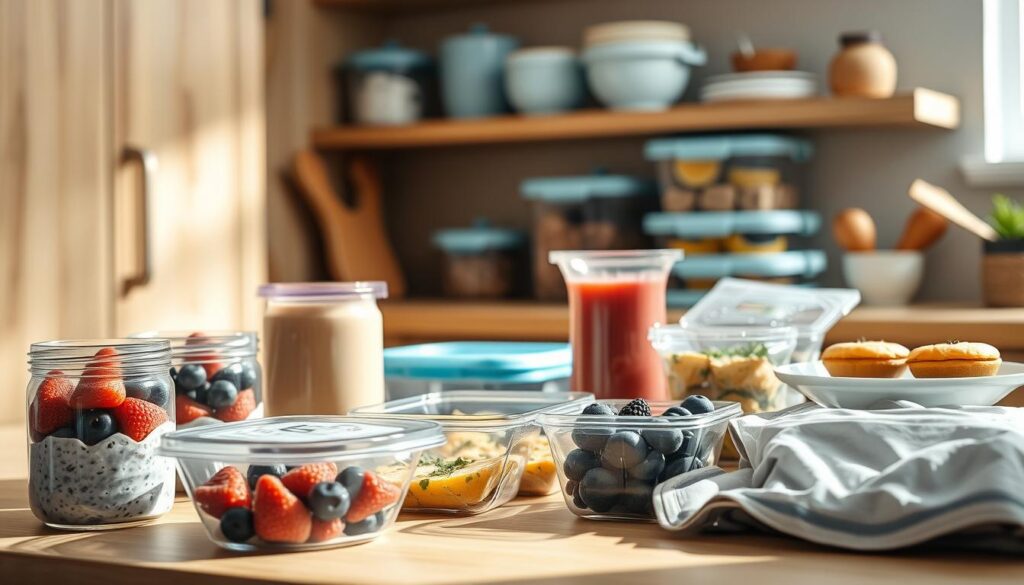
Blueberry Almond Baked Oatmeal: Inspired by EatingWell’s viral recipe, this dish combines rolled oats with fresh berries and crunchy almonds. The magic? Unsweetened applesauce keeps it moist through freezing. Portion into squares before storing—they reheat in 90 seconds.
- Southwest Egg Burritos: Scrambled eggs, black beans, and roasted poblano peppers wrapped in whole-grain tortillas. Pro tip: Wrap each in parchment paper before freezing to prevent sticking
- Savory Breakfast Cookies: Wholesome oats meet sharp cheddar and sun-dried tomatoes. These grab-and-go gems stay crisp when reheated in a toaster oven
Nutrition shines in every bite. The burritos pack 15g protein, while the oatmeal delivers 8g fiber per serving. Both use natural sweetness from ingredients like ripe bananas or roasted veggies—no added sugars required.
“Freezing meals transformed my A.M. routine. These recipes taste like I spent hours cooking—not 10 minutes reheating.”
Prep smart: Cool all items completely before freezing. Use airtight containers labeled with dates. For best texture, thaw overnight in the fridge. Your future self will thank you when mornings feel effortless and energizing.
Incorporating Protein and Fiber-Rich Additions
My morning energy used to crash by 10 AM until I discovered the power duo of protein and fiber. Now, every meal starts with this question: “How can I pair lasting fuel with satisfying texture?” The answer lies in smart ingredient combinations that work while you sleep.
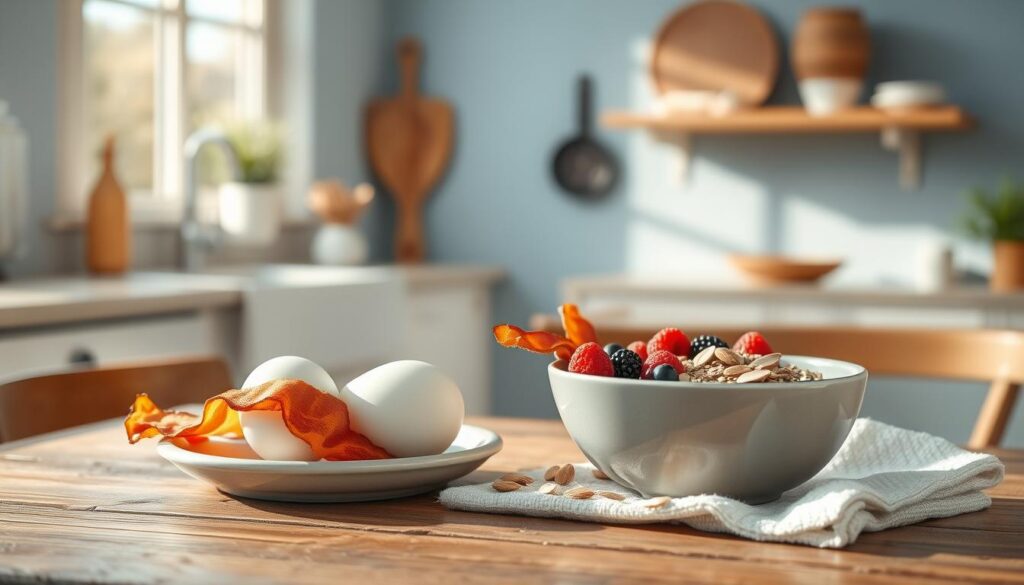
Protein builds and repairs—it’s your body’s maintenance crew. Fiber acts like a slow-burning log in your digestive fireplace. Together, they keep energy steady and hunger at bay. My go-to scramble? Three eggs with spinach (hello, iron!) and a sprinkle of sharp cheddar. The cheese adds richness without overwhelming other flavors.
Boost fiber effortlessly:
- Swap white toast for sprouted grain bread
- Mix chia seeds into oatmeal batter
- Top Greek yogurt with raspberries (8g fiber per cup!)
Last week’s experiment proved simple tweaks matter. Adding black beans to sweet potato hash increased its protein by 7 grams per serving. My partner didn’t even notice—just commented on the “heartier taste.”
| Protein Boosters | Fiber Boosters |
|---|---|
| 2 extra egg whites | 1/4 cup oats |
| 1/4 cup cottage cheese | 1 tbsp flaxseed |
| 1 scoop collagen peptides | 1/2 avocado |
Nutrition upgrades don’t require overhauling recipes. Stir hemp hearts into muffin batter. Blend silken tofu into smoothies. The key? Start small. Even a tablespoon of almond butter adds 4g protein to oatmeal.
Your turn: Next prep session, pick one protein and one fiber addition to test. Track how you feel until lunch. Adjust ratios based on what keeps you satisfied longest. Remember—the best meals match both your needs and taste buds.
Budget-Friendly Meal Prep Strategies
I nearly cried when my grocery bill hit $200—for one week. Turns out, smart prep begins before you even enter the store. Now I create meals that stretch ingredients across multiple recipes. Last month’s turkey bacon became breakfast burritos, salad toppers, and baked potato garnishes.
Build your plan around versatile staples. Rolled oats work in muffins, bars, and savory bowls. Canned beans add fiber to scrambles and egg wraps. My favorite hack? Roast a whole chicken Sunday night—use the meat for burritos and broth for cooking grains.
| Ingredient | Cost Per Serving | Recipe Uses |
|---|---|---|
| Dry black beans | $0.18 | Burritos, soups, dips |
| Bulk oats | $0.12 | Muffins, bakes, pancakes |
| Turkey bacon | $0.35 | Egg cups, salads, wraps |
Repurpose leftovers creatively. Extra roasted veggies? Fold them into tomorrow’s egg muffins. Stale bread becomes croutons or bread pudding. Store items in parchment paper packets—they prevent freezer burn better than plastic wrap.
Focus on fiber-rich bases that keep you full. Beans and whole grains cost less than specialty products. My go-to burrito formula: scrambled eggs + beans + $1 frozen peppers. Wrap in foil squares labeled with dates—they reheat beautifully in a toaster oven.
Small shifts create big savings. Buy spices in bulk bins. Choose frozen fruit over fresh for smoothies. Batch-cook muffin batter using discount bananas. Nourishing your body shouldn’t drain your wallet—with smart strategies, it won’t.
Utilizing Kitchen Tools for Efficient Prep
My nonstick skillet became a science experiment after forgetting chia pudding overnight. Now I rely on tools that simplify batch cooking and storage. The right equipment turns chaotic prep into smooth routines—no scrubbing required.
Must-Have Appliances and Utensils
Three tools revolutionized my freezer meals:
- Silicone muffin tins: Perfect for egg cups or oat bakes—pop portions out effortlessly
- High-quality nonstick pans: Cook delicate recipes like veggie-packed frittatas without sticking
- Stackable cooling racks: Speed up freezing while saving counter space
Last week’s cheese-and-spinach egg muffins slid out cleanly thanks to silicone liners. Cleanup took two minutes instead of twenty. Pro tip: Use parchment paper squares between burritos to prevent freezer cling.
Maximizing Freezer Space
Arrange meals like a Tetris master with these strategies:
| Container Type | Best For | Space Saved |
|---|---|---|
| Flat silicone bags | Pancakes, waffles | 40% vs. rigid containers |
| Square glass dishes | Casseroles, baked oats | 25% vs. round versions |
| Reusable foil packets | Breakfast wraps, sandwiches | Stack vertically |
Label everything with dates using washable markers. Rotate older items to the front weekly. For egg-free breakfast sandwiches, separate layers with parchment paper—they thaw without becoming soggy.
“Organizing my freezer felt overwhelming until I started using color-coded bins. Now I grab meals faster than my coffee brews.”
Small upgrades make big differences. A $10 egg cooker lets me prep six portions while chopping vegetables. Sturdy glass containers withstand daily reheating—worth every penny for stress-free mornings.
Navigating Storage and Container Options
I once opened my refrigerator to find a science experiment—green fuzz growing on forgotten egg muffins. Now I use containers that keep meals fresh and visible. The right storage turns chaotic mornings into smooth operations where every burrito and veggie-packed bake stays delicious for weeks.
Glass containers with locking lids work best for refrigerator storage. They prevent odors from mingling and handle reheating beautifully. For freezer burritos, reusable silicone bags save space while preventing ice crystals. My favorite combo:
| Container Type | Best For | Pro Tip |
|---|---|---|
| 1-cup glass jars | Oatmeal bakes, chia pudding | Leave ½ inch headspace for expansion |
| Flat silicone bags | Breakfast burritos, pancakes | Separate layers with parchment paper |
| Sectioned bento boxes | Veggie scrambles, muffin combos | Use wax paper between compartments |
Label everything clearly—masking tape and sharpies beat guessing games. Include:
- Meal name (“Southwest Black Bean Burritos”)
- Prep date
- Reheating instructions (e.g., “Oven 350°F – 8 mins”)
For extra flavor, sprinkle cinnamon on reheated sweet potato hash or oatmeal. The spice adds warmth without added sugar. Last week’s apple-cinnamon baked oats tasted fresher after freezing than they did day one—proof that smart storage preserves quality.
Rotate older meals to the front weekly. Store burritos vertically like files in a cabinet—you’ll spot them faster during rushed mornings. With these strategies, your prepped creations stay organized and appetizing until the last bite.
User Experiences and Recipe Tweaks
Sarah, a nurse and mom of three, once texted me at 5 AM: “My egg muffins tasted like hockey pucks—help!” Her story mirrors many others I’ve heard. Through trial, error, and smart adjustments, she now makes freezer meals her family devours. Here’s how real people transformed their mornings.
Real-Life Success Stories
Mark, a firefighter, shares: “Swapping sweetener for mashed banana in my oatmeal bake was a game-changer. My crew actually asks for seconds now.” His tweak adds natural sweetness while boosting fiber—a win for taste and nutrition.
Teachers Lisa and Raj found success with savory breakfast bowls. “Adding roasted cauliflower to egg scrambles gave them heartier texture,” Lisa explains. “Now we grab them between morning meetings without crashing by recess duty.”
- Flavor balance: Dental hygienist Mia uses smoked paprika instead of sugar in sweet potato hash—adds depth without sweetness
- Texture fix: College student Diego stirs chia seeds into muffin batter to prevent freezer dryness
- Time saver: Grandma Eleanor preps pancake batter in reused yogurt containers—thaws perfectly for toddler breakfasts
“Starting with simple breakfast meal prep gave me confidence to experiment. Now I adjust recipes based on what’s seasonal—or what my kids haven’t hidden in the couch.”
These stories prove kitchen wins come through persistence, not perfection. Whether you’re swapping spices or repurposing leftovers, small changes create meals that fuel your day—and your determination.
Conclusion
My frantic search for car keys used to ruin more mornings than I’d like to admit—until prepped meals became my secret weapon. Now, grabbing fuel takes less time than untangling headphones. That’s the magic of planning: turning chaotic starts into calm, nourishing routines.
Batch cooking transforms kitchen work into freedom. A one-hour freezer cooking session creates ready-to-heat meals for days. Think cinnamon-kissed oatmeal bakes or veggie-packed egg cups. These recipes adapt to your schedule—swap ingredients based on what’s seasonal or on sale.
Your oven and microwave become allies. Reheat burritos until crispy, or warm muffin cups gently. Both methods preserve texture better than you’d expect. Pro tip: Sprinkle oats with nutmeg before freezing—it adds warmth without extra sugar.
Start small. Try beginner-friendly meal planning with two recipes weekly. Track how you feel post-breakfast. Adjust spice levels or cooking times as needed. Share your twists with friends—they might add their own genius hacks.
Remember: Nourishment shouldn’t mean stress. With smart prep, mornings become moments to savor—not survive. Your future self will thank you when breakfast tastes like victory, not an afterthought.

